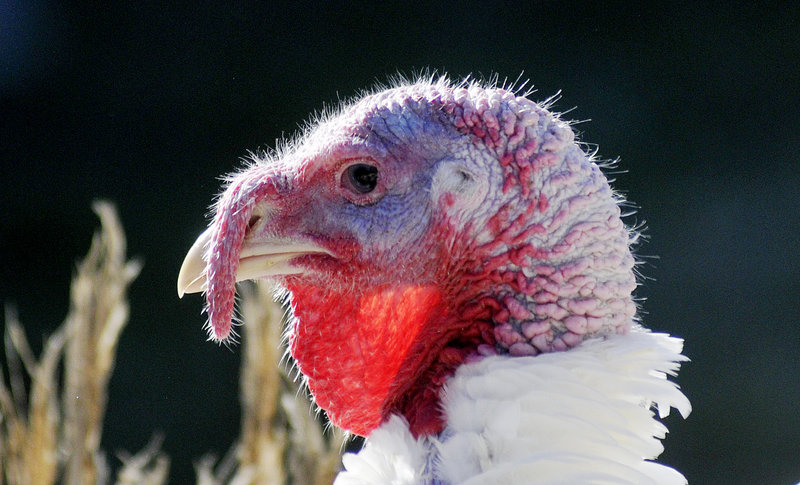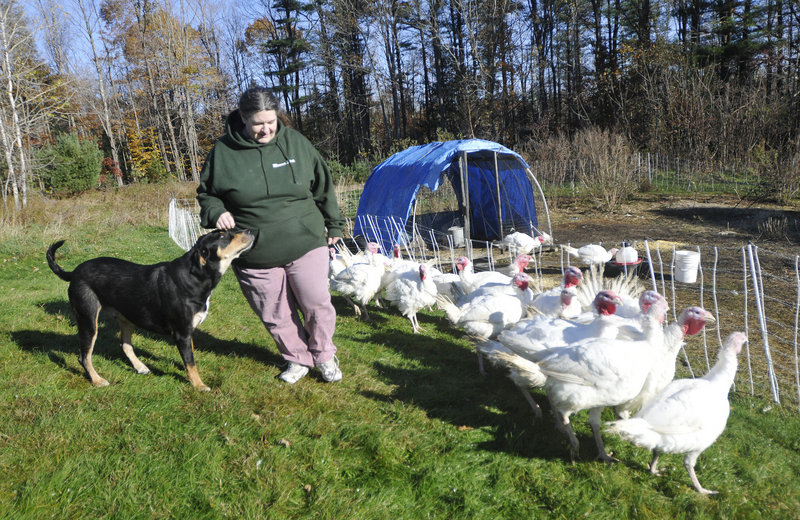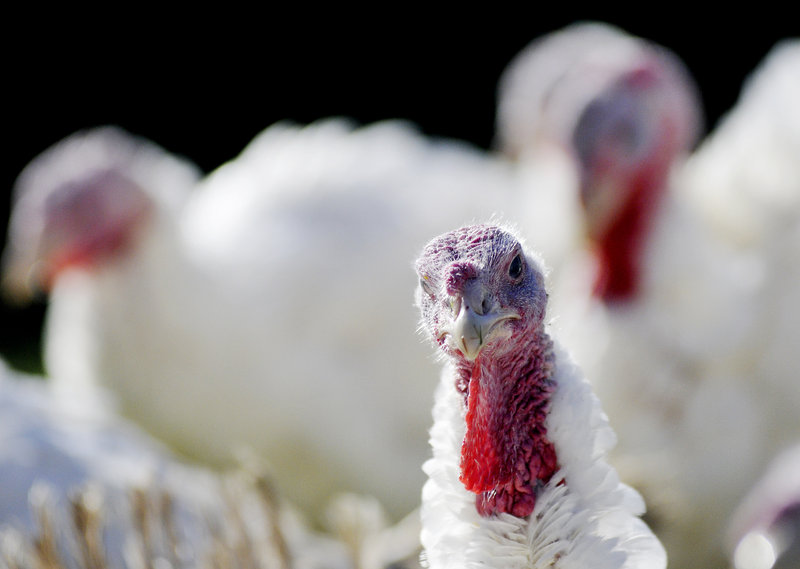Choosing a Thanksgiving turkey has become even more complicated than a stroll down the cereal aisle.
Should you buy fresh or frozen? Free-range and organic, or a heritage bird? Kosher, self-basting or premium? Hen versus tom turkey? Just a breast or a whole bird?
Here’s a guide to what all this turkey terminology means, along with a list of local farms that still have birds available for your table:
Fresh or frozen?
Turkeys can be called fresh if they have been stored at 26 degrees Fahrenheit or above, according to the National Turkey Federation. (Turkey meat does not freeze at 32 degrees.) Sometimes they’ll have a little ice on the skin, but that does not mean they’ve been frozen. Fresh turkeys are convenient because you don’t have to thaw them, but they are typically a little more expensive than frozen, and have a shorter shelf life.
Frozen, or “previously frozen,” turkeys may have been processed months ago. They are flash-frozen right after processing down to 0 degrees or below.
There’s also a category called “hard chilled.” These birds are stored between 0 and 26 degrees, and have a similar shelf life as a fresh bird. Their label may say “not previously frozen.” The U.S. Department of Agriculture created this category because it felt that birds that are hard to the touch should not be labeled “fresh.”
As far as taste goes, a few years ago, Cooks Illustrated did a taste test where frozen birds actually scored higher than fresh ones that had been stored at slightly above freezing. The conclusion was that as the temperature fluctuates in the fresh birds during transport, the ice crystals that form break through the cell walls and dry out the meat.
But not everyone agrees with that finding.
“Obviously, I think the longer any product is frozen, the quality definitely wanes, for sure,” said Ben Forbes, meat team leader at Whole Foods Market in Portland.
Forbes said Whole Foods’ frozen birds are processed just a few weeks before they end up in the store. “The frozen quality is amazing, but you still can’t beat a fresh, processed bird for Thanksgiving, I think,” he said.
What’s the difference between a hen and a tom turkey, and does one taste better than the other?
A hen is a female bird; a tom is male. How they taste will depend primarily on where and how they were raised. The main difference is size; a tom will be larger than a hen. Designating whether a turkey is a hen or a tom is not required on the label.
What about hormones and antibiotics?
Some turkey farmers use antibiotics to keep their flocks healthy, but federal regulations do not allow poultry to be treated with hormones. So when you see “hormone-free” on a turkey label, that’s just a marketing tactic the producer uses to set your mind at ease and perhaps lure you into buying his bird over another brand.
What’s a “young turkey?”
Turkeys less than 8 months old.
What is a “self-basted” turkey?
Self-basted turkeys have been injected with or marinated in a solution that contains fat, broth or water, spices, flavor enhancers and other approved substances.
Do organic and free-range turkeys really taste better?
First of all, what do those terms really mean? A certified organic turkey eats organic feed, has access to the outdoors and has never been given antibiotics.
The term “free-range” means the birds have access to the outdoors. But birds can be outdoors and still be crowded into pens. It’s the amount of space each turkey has, not whether they are indoors or outdoors, that determines how tasty the meat will be on your Thanksgiving table.
The 50 organic, free-range turkeys raised at Whispering Winds Farm in Mechanic Falls are “totally free-range,” said Paula Stotts, who runs the farm with her husband, Mark.
“If you come to my doorstep, you have a good chance of being met by a turkey this time of year,” she said. “We have the advantage of living at a dead-end road and owning the land all around us.”
After the farm’s gardens are emptied for the year, the turkeys are allowed to graze in those areas. Their diets are supplemented with organic grain and, at this time of year, also some organic cracked corn.
The farm usually raises a couple hundred birds, but has had trouble finding a way to process them. (Food & Dining covered this issue in the Oct. 12 edition.) Organic, free-range birds are in such demand, however, that the Stotts have been sold out of Thanksgiving turkeys since July, and already have a waiting list of 25 for next year.
Stotts is convinced they are popular because the flavor is so much better.
“You’ll get new clients who have never had it before, and once they have it, they won’t go back,” she said. “They say that the store-bought tastes like wet cardboard. I know that there is a difference, in my opinion, in the quality of the meat. And even a larger turkey that’s raised this way doesn’t take near as long to cook as a conventional and agribusiness-grown turkey.”
What’s the advantage of buying a kosher turkey?
Kosher turkeys are birds that have been processed under the supervision of a rabbi. These turkeys are salted as part of the kosher processing, which gives a taste and tenderness that has been compared to a brined bird. Some stores are now selling pre-brined turkeys, which makes getting the most flavorful meat even easier.
What’s a heritage turkey?
Most of the turkeys you see in the store are Broad-Breasted Whites, the breed commercial turkey growers embraced at the expense of older breeds. Americans like a lot of breast meat on their birds, and Broad-Breasted Whites have been bred to have so much breast meat, they have been known to fall over and be unable to walk well because they are so off-balance.
Heritage turkeys, such as the Bourbon Red or the Narragansett, can breed naturally, and they can fly. They take twice as long to grow as commercial birds, but that just means they have more time to develop a fuller flavor. Their legs are an inch or two longer than commercial birds, and they have a longer body.
“All of them are humanely and healthfully raised,” said Roger Mastrude, president of the non-profit Heritage Turkey Foundation in California, which is working to bring back the birds.
Mastrude says demand is continuing to grow for heritage turkeys because they are so flavorful, but demand often outstrips supply.
“There are a lot of logistics problems involved with bringing back heritage turkeys,” he said. “I really try to support small farmers, but the commercial reality is, it takes a larger farmer to deal with federal regulation and stuff like that. But even the largest heritage turkey producers in the country are tiny compared to the commercial turkey and poultry industry.”
Heritage turkeys are more expensive because it takes so long to raise them, and they tend to be fed organic food. Small farms, if you can find one that’s not already sold out, are often the best bet for buying a heritage turkey, because you won’t have to pay shipping charges. You can search for a farm in your area by going to localharvest.org. (See the list of local turkey farms at right to find heritage birds in Maine.)
You can also buy them online at heritagefoodsusa.com, but shipping will bring the price of a single turkey to more than $100.
How large a bird should I buy?
Most sources recommend 1 pound of turkey per person, or 1 1/2 pounds if you want enough for seconds and leftovers. Ben Forbes, meat team leader at Whole Foods Market in Portland thinks 1 1/2 to 2 pounds per person is more appropriate, especially if you want lots of leftovers.
Staff Writer Meredith Goad can be contacted at 791-6332 or at: mgoad@pressherald.com
Twitter: MeredithGoad
Send questions/comments to the editors.






Success. Please wait for the page to reload. If the page does not reload within 5 seconds, please refresh the page.
Enter your email and password to access comments.
Hi, to comment on stories you must . This profile is in addition to your subscription and website login.
Already have a commenting profile? .
Invalid username/password.
Please check your email to confirm and complete your registration.
Only subscribers are eligible to post comments. Please subscribe or login first for digital access. Here’s why.
Use the form below to reset your password. When you've submitted your account email, we will send an email with a reset code.